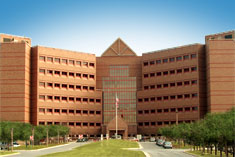Brooke Army Medical Center facts for kids
Quick facts for kids Brooke Army Medical Center |
|
|---|---|
 |
|
| Active | 1946–present |
| Country | |
| Allegiance | United States of America |
| Branch | United States Army |
| Type | Hospital |
| Role |
|
| Size | 450 beds |
| Garrison/HQ | Fort Sam Houston |
| Website | https://bamc.tricare.mil |
| Commanders | |
| Current commander |
Colonel Mark Stackle |
| Insignia | |
| Identification symbol |
 |
Brooke Army Medical Center (BAMC) is a very important hospital for the United States Army. It is located at Fort Sam Houston in San Antonio, Texas. BAMC is a large hospital with 425 beds. It is the biggest medical facility in the Department of Defense. It is also the only Level I trauma center for the Department of Defense. This means it can handle the most serious injuries.
BAMC is also home to the Center for the Intrepid. This is a special place where injured service members get help to recover. More than 8,000 soldiers, airmen, sailors, and civilians work at BAMC. They provide care to wounded service members and people from the San Antonio area.
Contents
The History of BAMC
Brooke Army Medical Center has a long history. It started way back in 1879 as a small medical office.
Early Hospitals at Fort Sam Houston
The first hospital at Fort Sam Houston was a small wooden building. It was just a place to get medicine. In 1886, a permanent brick hospital was built. Later, in 1908, a bigger hospital called the Station Hospital was built. It had 84 beds.
In 1929, a leader named Brigadier General Roger Brooke took charge of the Station Hospital. He was very important because he started using chest X-rays for military patients. This was a new idea at the time. In 1936, construction began on an even newer Station Hospital. This large hospital opened in 1937 with 418 beds. It cost $3 million to build. This new hospital helped make Fort Sam Houston a major medical center for the Army.
During World War II, the Station Hospital got ready for many injured soldiers. They turned a building where soldiers lived into extra patient rooms.
Brooke General Hospital
In 1942, the Station Hospital was renamed Brooke General Hospital. This was done to honor Brigadier General Roger Brooke. In 1944, another building was turned into a recovery unit for soldiers coming back from the war. This building later became known as Beach Pavilion.
Becoming Brooke Army Medical Center
In 1946, Fort Sam Houston was chosen to be the main place for Army medical training. Because of this, Brooke General Hospital was renamed Brooke Army Medical Center. This made it the center for both medical care and training.
Years later, in 1987, work began on a brand new hospital building. The new BAMC facility was officially opened in 1996. Patients were moved from the old hospital to the new one. The old BAMC building is now used by other Army groups.
Changes and New Names
In 2011, due to a big military change called Base realignment and closure (BRAC), BAMC took over the inpatient care from the Air Force's Wilford Hall Medical Center. For a while, the combined hospital was called San Antonio Military Medical Center (SAMMC). However, since October 2017, the name SAMMC is no longer used. The entire hospital and its clinics are now known as BAMC again. BAMC works closely with Air Force medical teams in the San Antonio area.
What BAMC Does Today
Today, BAMC is a 425-bed hospital. It can even expand to 653 beds if there is a disaster. It offers many services, including:
- General medical and surgical care
- Clinics for adults and children
- A 24-hour Emergency department
- Specialty clinics for different health needs
- Wellness and prevention services
BAMC is the only MEDCOM Level I trauma center in the Department of Defense. This means it is a top hospital for treating severe injuries. It is also a teaching hospital, helping to train new doctors and medical staff.
BAMC is home to the U.S. Army Institute of Surgical Research (USAISR) Burn Center. This is a very important center that treats severe burns. It is the only burn center in the Department of Defense that is approved by the American Burn Association.
The original Brooke General Hospital building from 1937 is a historic landmark. It was added to the National Register of Historic Places in 2001.
Expanding BAMC for the Future
Because of the BRAC changes in 2005, BAMC needed to get bigger to handle more patients. This meant adding new parts to the hospital.
The Consolidated Tower
Construction started in 2009 on a large new building called the Consolidated Tower, or CoTo. This addition made the hospital much bigger. It added space for offices, a children's clinic, a larger Emergency and Trauma department, and special care units. It also expanded the USAISR Burn Center, adding more beds for burn patients.
New Parking Garage
To make room for more people, a large parking garage was also built. It has space for 5,000 cars. Construction on this garage also began in 2009.
Central Energy Plant
Because the hospital became so much larger, it needed more power for heating and cooling. A new central energy plant was built to provide this extra power.


